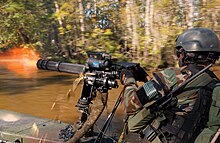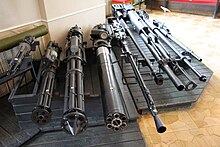Rotary cannon

A rotary cannon, rotary autocannon, rotary gun or Gatling cannon, is any large-caliber multiple-barreled automatic firearm that uses a Gatling-type rotating barrel assembly to deliver a sustained saturational direct fire at much greater rates of fire than single-barreled autocannons of the same caliber. The loading, firing and ejection functions are performed simultaneously in different barrels as the whole assembly rotates, and the rotation also permits the barrels some time to cool. The rotating barrels on nearly all modern Gatling-type guns are powered by an external force such as an electric motor, although internally powered gas-operated versions have also been developed.
The cyclic multi-barrel design synchronizes the firing/reloading sequence. Each barrel fires a single cartridge when it reaches a certain position in the rotation, after which the spent casing is ejected at a different position and then a new round loaded at another position. During the cycle, the barrel has more time to dissipate some heat away to the surrounding air.
Due to the usually cumbersome size and weight of rotary cannon, they are typically mounted on weapons platforms such as vehicles, aircraft, or ships, where they are often used in close-in weapon systems.
History[]
In 1852 a revolving barrel gun with a unique method of ignition was proposed by an Irish immigrant to America by the name of Delany.[1]
The Gatling gun was another gun to use rotating barrels. It was designed by the American inventor Dr. Richard J. Gatling in 1861 and patented in 1862.[2] Hand cranked and hopper fed, it could fire at a rate of 200 rounds per minute. The Gatling gun was a field weapon, first used in warfare during the American Civil War and subsequently by European and Russian armies.
The design was steadily improved; by 1876 the Gatling gun had a theoretical rate of fire of 1,200 rounds per minute, although 400 rounds per minute was more readily achievable in combat. By 1893, the M1893 Gatling gun could fire 800 to 900 rounds per minute. Ultimately the Gatling's weight and cumbersome artillery carriage hindered its ability to keep up with infantry forces over difficult ground and was superseded by lighter and more mobile machine guns such as the Maxim gun. All models of Gatling guns were declared obsolete by the U.S. Army in 1911, after 45 years of service.
Development of modern Gatling-type guns[]

After the Gatling gun was replaced in service by newer recoil- or gas-operated non-rotating machine guns, the approach of using multiple rotating barrels fell into disuse for many decades. However, some examples were developed during the interwar years but only existed as prototypes, or rarely used. During World War I, Imperial Germany worked on the Fokker-Leimberger, an externally powered 12-barrel Gatling gun that could fire more than 7,200 7.92×57mm rounds per minute.[3]
After World War II, the U.S. Army Air Force determined that an automatic cannon of improved design with an extremely high rate of fire was required to achieve a sufficient number of large-caliber hits on fast-moving enemy jet aircraft. Using experience gained from 20mm MG 151 and 30mm MK 108 cannon used by Luftwaffe aircraft, a larger-caliber cannon shell for the new gun was deemed desirable, as it contained room for an explosive with more destructive force than the .30 and .50 caliber machine gun cartridges previously employed, and thus capable of destroying aircraft with only a few hits on target.
In June 1946, the General Electric Company was awarded a U.S. military defense contract to develop an aircraft gun with a high rate of fire which GE termed Project Vulcan. While researching prior work, ordnance engineers recalled the experimental electrically driven Gatling weapons of the turn of the 20th century. In 1946, a Model 1903 Gatling gun borrowed from a museum was set up with an electric motor drive and test-fired by General Electric engineers. The 40-year-old design briefly managed a rate of fire of 5,000 rounds per minute.
In 1949 General Electric began testing the first model of its modified Gatling design, now called the Vulcan Gun. The first prototype was designated the T45 (Model A). It fired .60 in (15 mm) ammunition at about 2,500 rounds per minute, from six barrels driven by an electric motor. In 1950, GE delivered ten initial model A .60 cal. T45 guns for evaluation. Thirty-three model C T45 guns were delivered in 1952 in three calibers: .60 cal., 20mm, and 27mm, for additional testing. After extensive testing, the T171 20mm gun was selected for further development. In 1956, the T171 20mm gun was standardized by the U.S. Army and U.S. Air Force as the M61 20mm Vulcan aircraft gun.


One of the main reasons for the resurgence of the electrically or hydraulically powered multiple-barrel design is the weapon's tolerance for continuous high rates of fire. For example, 1000 rounds per minute of continuous fire from a conventional single-barrel weapon ordinarily results in rapid barrel heating followed by stoppages caused by overheating. In contrast, a five-barreled machine gun firing 1000 rounds per minute fires only 200 rounds per barrel per minute, an acceptable rate of fire for continuous use. The only limiting factor is the rate at which loading and extraction can occur. In a single-barrel design, these tasks must alternate; a multiple-barrel design allows them to occur simultaneously, using different barrels at different points in the cycle. The design also solves the problem of defective ammunition, which can cause a normal machinegun to malfunction when a cartridge fails to load, fire, or eject from the weapon. As it is powered by an independent source, the gun simply ejects the defective round along with the rest of the cartridges while continuing to operate.
Models[]
M61 Vulcan and other designs[]
The M61 Vulcan 20 mm autocannon is the best-known of a family of weapons designed by General Electric and currently manufactured by General Dynamics. The M61 is a six-barreled 20mm rotary cannon that fires at up to 6,600 rounds per minute.[4] Similar systems are available in calibers ranging from 5.56 mm to 30 mm (the prototype T249 Vigilante AA platform featured a 37 mm chambering).
Another multi-barrel design is the hydraulically driven GAU-8 Avenger 30 mm autocannon, carried on the A-10 Thunderbolt II (Warthog) attack aircraft, a heavily armored close air-support aircraft. It is a seven-barreled cannon designed for tank-killing and is currently the largest bore multi-barrel weapon active in the U.S. arsenal, and heaviest autocannon ever mounted into an aircraft, outweighing the WW II German Bordkanone BK 7,5 75mm aircraft-mount, tank-killing single barrel autocannon by some 630 kg (1,389 lb), with ammunition.
The Gryazev-Shipunov GSh-6-23 and GSh-6-30 are Russian gas-powered rotary cannon with maximum cyclic rates of 9,000 to 10,000 rounds per minute.
Self-driven examples[]
While electric motors were used to rotate the Vulcan barrels, a few examples of self-operated Gatling-derived weapons use the blow-forward, recoil or gas impulse from their ammunition. The Bangerter machine gun uses a blow-forward operation and is the most complex example. The Slostin machine gun uses a similar operation but with gas pistons on each barrels. The GShG-7.62 machine gun and GSh-6-23, both use a more effective, simpler gas piston drive in the centre of the barrel cluster.
Minigun[]

Technically not a "cannon", the Minigun is more correctly classified as a rotary machine gun. During the Vietnam War, the 7.62 mm caliber M134 Minigun was originally created to arm rotary-wing aircraft, and could be fitted to various helicopters as either a crew-served or a remotely operated weapon. With a rate of fire from 2,000 to 6,000 rounds per minute[5] from a 4,000-round linked belt, the Minigun proved to be one of the most effective non-explosive projectile weapons ever built[citation needed] and is still used in helicopters today.
As the GAU-2B/A, the Minigun was also used on the U.S. Air Force AC-47, AC-119 and Lockheed AC-130 gunships. The AC-47 was known during the Vietnam War as "Puff the Magic Dragon" and was said to be "the only thing that scared the VC". This weapon was also used on selected USAF helicopters. With sophisticated navigation and target identification tools, Miniguns can be used effectively even against concealed targets. The crew's ability to concentrate the Minigun's fire very tightly produces the appearance of the 'Red Tornado'[6] from the light of the tracers, as the gun platform circles a target at night.
See also[]
- Revolver cannon
- Chain gun
- List of multiple barrel firearms
References[]
- ^ "United Service Journal: Devoted to the Army, Navy and Militia of the United States". 1851.
- ^ Greeley, Horace; Leon Case (1872). The Great Industries of the United States. J.B. Burr & Hyde. p. 944. Retrieved 2016-10-23.
- ^ "Correspondence: "Motor Guns-A flashback to 1914-18".", Flight, pp. 313–314, 8 March 1957, archived from the original on 2 October 2015, retrieved 28 February 2011
- ^ Some versions feature a selectable rate of fire, either 4,000 or 6,000 rounds per minute
- ^ Initially, the M134 had a rate of fire of 6,000 rounds per minute (rpm). This was changed when a variable speed transmission was introduced, giving two selectable rates of fire of 2,000 and 4,000 rpm.
- ^ AC-119K Stinger Gunship Photo 1. Archived 2010-12-12 at the Wayback Machine
External links[]
- Autocannon
- Rotary cannon
- Multi-barrel machine guns
